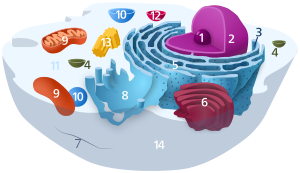Lysosomal enzymes
| Cell biology | |
|---|---|
| The animal cell | |

Components of a typical animal cell:
|
A lysosome is a membrane-bound organelle found in nearly all animal cells. They are spherical vesicles which contain hydrolytic enzymes that can break down virtually all kinds of biomolecules. Simply stated, a lysosome is a type of vesicle with specific composition, of both its membrane proteins, and proteins of its lumen. The lumen's pH (4.5 - 5.0) is optimal for the enzymes involved in hydrolysis, analogous to the activity of the stomach. Besides degradation of polymers, the lysosome is involved in various cell processes, including secretion, plasma membrane repair, cell signaling, and energy metabolism.
The lysosomes also act as the waste disposal system of the cell by digesting unwanted materials in the cytoplasm, both from outside of the cell and obsolete components inside the cell. Material from the outside of the cell is taken-up through endocytosis, while material from the inside of the cell is digested through autophagy. Their sizes can be very different—the biggest ones can be more than 10 times bigger than the smallest ones. They were discovered and named by Belgian biologist Christian de Duve, who eventually received the Nobel Prize in Physiology or Medicine in 1974.
Lysosomes are known to contain more than 60 different enzymes. Enzymes of the lysosomes are synthesised in the rough endoplasmic reticulum. The enzymes are imported from the Golgi apparatus in small vesicles, which fuse with larger acidic vesicles. Enzymes destined for a lysosome are specifically tagged with the molecule mannose 6-phosphate, so that they are properly sorted into acidified vesicles.
...
Wikipedia
